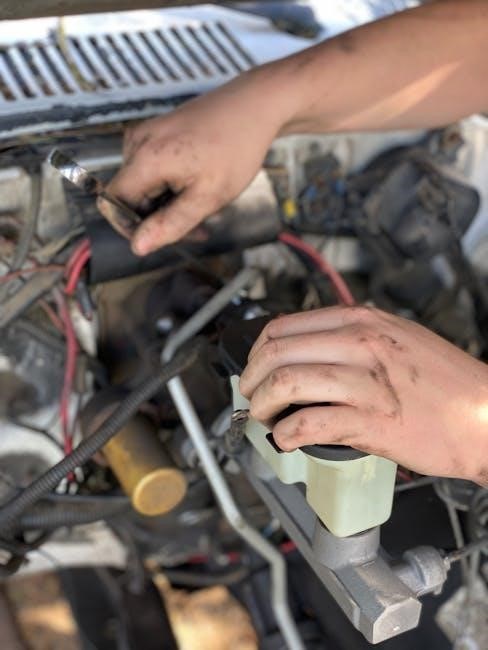This manual is essential for setting up and maintaining your Craftsman 1/2 HP garage door opener․ It provides detailed instructions for installation, operation, and troubleshooting, ensuring smooth functionality and safety․
Overview of the Garage Door Opener System
The Craftsman 1/2 HP garage door opener system is designed for efficient and reliable operation․ It features a robust motor, compatibility with various garage door types, and advanced safety mechanisms․ The system includes a remote control, keypad, and push-button station for convenient access․ With detailed instructions and clear diagrams, the manual ensures proper installation and maintenance․ Regular upkeep, such as lubricating moving parts and checking door balance, is crucial for optimal performance․ The opener also supports smart home integration via myQ Wi-Fi compatibility, enhancing user convenience and control․
Importance of Reading the Manual
Reading the manual is crucial for understanding the Craftsman 1/2 HP garage door opener’s operation and maintenance․ It provides detailed instructions, safety guidelines, and troubleshooting tips to ensure proper installation and function․ The manual includes step-by-step guides, diagrams, and essential safety precautions to avoid potential hazards․ By following the manual, users can optimize performance, prevent damage, and extend the system’s lifespan․ It serves as a comprehensive guide for both DIY enthusiasts and professionals, ensuring a smooth and safe experience․
Key Features of the 1/2 HP Model
The Craftsman 1/2 HP garage door opener features a robust motor designed for reliable performance․ It includes a belt-drive system for smooth, quiet operation and is suitable for standard garage doors․ The model offers energy efficiency, a compact design, and compatibility with various accessories․ Its DC motor ensures consistent power delivery, while advanced security features like rolling code technology enhance safety․ This model strikes a balance between power and efficiency for everyday use․

Technical Specifications
- Motor: 1/2 HP DC motor for smooth operation․
- Voltage: 120V AC, 60Hz power requirement․
- Weight: Approximately 30 lbs for easy installation․
- Dimensions: Compact design fits standard garage setups․
- Compatibility: Works with doors up to 350 lbs․
Motor Size and Power
The Craftsman 1/2 HP garage door opener features a powerful yet efficient DC motor․ Designed for smooth and quiet operation, this motor delivers reliable performance for standard residential garage doors․ With 1/2 horsepower, it provides ample power to handle doors up to 350 lbs, ensuring consistent and durable functionality․ This energy-efficient design minimizes noise and maximizes longevity, making it ideal for daily use without compromising on strength․
Compatibility with Garage Door Types
The Craftsman 1/2 HP garage door opener is designed to work seamlessly with various garage door types, including sectional, roll-up, and single or double car doors․ It is compatible with doors weighing up to 350 lbs, ensuring smooth operation for most residential setups․ This versatility makes it a reliable choice for homeowners with different garage door configurations, providing consistent performance across various door styles․
Weight and Dimensions
The Craftsman 1/2 HP garage door opener is designed to be lightweight and compact, making installation easier․ The motor unit typically weighs around 30 lbs, while the rail measures approximately 40 inches in length․ Its dimensions ensure it fits standard garage setups without requiring additional space․ The lightweight design allows for smooth operation and easier handling during installation or maintenance․

Safety Precautions
Always disconnect power before servicing․ Ensure proper installation to avoid accidents․ Wear protective gear when handling tools․ Keep children away during operation and maintenance․
General Safety Guidelines
Always disconnect power before performing maintenance or repairs․ Ensure the garage door is properly balanced and aligned․ Wear protective eyewear and gloves when handling tools or components․ Keep children and pets away from moving parts․ Never operate the door while standing beneath it․ Regularly inspect springs, cables, and rollers for wear․ Follow all instructions carefully to avoid accidents or injuries․ Ensure the opener is installed by a qualified professional if unsure․
Warnings and Cautions
Never attempt repairs without proper knowledge or tools․ Always ensure the garage door is fully closed before adjusting or servicing the opener․ Avoid modifying the opener or its components, as this may void the warranty or cause malfunctions․ Keep loose clothing and long hair tied back when working near moving parts․ Do not test the safety reversal feature without ensuring the area is clear of obstacles or people․ Misuse can lead to injury or damage․
Emergency Procedures
In case of an emergency, disconnect power immediately using the manual release handle․ Pull the red emergency cord to disengage the door from the opener․ Never attempt to stop a falling door manually․ If the door starts to close unexpectedly, stand clear and avoid contact․ Ensure all people and pets are at a safe distance․ Contact a professional if the opener malfunctions or if safety features fail to engage properly․

Installation Steps
- Unpack and inventory all parts carefully;
- Assemble the opener following the manual instructions․
- Secure the unit to the ceiling properly․
- Attach the door arm to the garage door․
- Install the remote and keypad․
- Test the system to ensure smooth operation․
Pre-Installation Checklist
- Verify the opener’s compatibility with your garage door type and size․
- Ensure the door is balanced and in good working condition․
- Clear the garage floor and surrounding areas for safe installation․
- Gather all tools and hardware provided in the kit․
- Check for proper ceiling clearance and structural integrity․
- Consult a professional if you’re unsure about any step․
- Review the manual thoroughly to understand the process․
Mounting the Opener
To mount the Craftsman Garage Door Opener 1/2 HP, begin by locating the center of your garage door and marking it for accurate installation․ Attach the mounting bracket securely to the door using the provided screws, ensuring they are tightly fastened to avoid any movement․ Next, lift the opener unit and place it onto the bracket, securing it with the included bolts․ Tighten the bolts firmly but avoid over-tightening to prevent damage․ Then, connect the chain or belt to the opener and door, adjusting the tension as specified in the manual for smooth operation․ Finally, test the opener by operating the door several times to ensure it functions correctly․ Always maintain proper clearance from the ceiling and walls for optimal performance and safety․ If unsure, consider consulting a professional or additional resources for guidance․
Connecting the Door and Opener
Connect the garage door to the opener by attaching the chain or belt to the door arm․ Align the door arm with the opener’s sprocket or pulley, ensuring proper alignment for smooth operation․ Secure the connection using the provided hardware, tightening all bolts firmly․ Adjust the chain or belt tension according to the manual’s instructions to prevent slack or over-tightening․ Test the system by opening and closing the door to ensure it operates evenly and quietly․ Always follow safety guidelines to avoid accidents during this process․
Final Safety Checks
After installation, perform final safety checks to ensure proper function․ Test the emergency stop feature by pulling the red cord․ Check door balance by manually operating it—it should stay in place when partially open․ Inspect all connections and bolts for tightness․ Test safety sensors by obstructing the door’s path to confirm it reverses․ Ensure the door aligns with the opener and operates smoothly without noise or resistance․

Programming the Remote and Keypad
Sync the remote by pressing the learn button on the opener․ Enter a PIN on the keypad and test operation to ensure proper function and security․
Remote Control Programming
To program the remote control, locate the “learn” button on the garage door opener․ Press and hold it until the LED light blinks․ Enter a new code on the remote keypad, ensuring it matches the opener’s settings․ Test the remote to confirm proper operation․ If issues arise, repeat the process or consult the manual for troubleshooting steps․ Always ensure the remote is synced securely for reliable performance and safety․
Keypad Programming Instructions
Enter your chosen PIN on the keypad, then press and hold the “Enter” button until the opener’s light blinks․ Locate the “Learn” button on the opener and press it briefly․ Re-enter your PIN to confirm programming․ Test the keypad to ensure it operates the door smoothly․ If issues occur, refer to the manual for additional guidance or troubleshooting steps to resolve the problem efficiently․
Resetting the Opener
Locate the “Learn” button on the opener, typically near the motor․ Press and hold it for 10 seconds until the lights blink, indicating a reset․ Release the button and wait for the system to complete the reset process․ All programmed remotes and keypads will be cleared․ Reprogram each device following the manual’s instructions․ Test the door’s operation to ensure proper function․ If issues persist, consult the manual or contact support for further assistance․

Maintenance and Troubleshooting
Regularly lubricate moving parts, inspect hardware, and check door balance․ Address common issues like misaligned sensors or worn parts promptly to ensure smooth operation and longevity․
Regular Maintenance Tips
Regular maintenance is essential to ensure the longevity and smooth operation of your Craftsman 1/2 HP garage door opener․ Lubricate moving parts like rollers and springs with silicone-based spray․ Inspect belts or chains for wear and tear․ Check safety sensors alignment and clean them if necessary․ Tighten all bolts and screws periodically․ Verify door balance by disconnecting the opener; it should stay in place․ Test emergency release handles and ensure proper function․ Replace worn parts promptly and refer to the manual for specific maintenance schedules․
Common Issues and Solutions
Common issues with the Craftsman 1/2 HP garage door opener include the door not closing properly, remote malfunction, or unusual noises․ Solutions often involve realigning safety sensors, replacing remote batteries, or lubricating moving parts․ For grinding noises, inspect and grease rollers or springs․ If the door reverses unexpectedly, check for obstructions or adjust force sensitivity settings․ Refer to the manual for diagnostic charts and troubleshooting guides to address specific problems effectively․
When to Call a Professional
If issues persist after troubleshooting or DIY repairs, or if you encounter complex problems like motor failure or electrical issues, it’s best to contact a professional․ Heavy doors or damaged springs also require expert handling․ For safety, hire a certified technician familiar with Craftsman systems to ensure proper repairs and avoid further damage or risks․

Understanding the User Manual
The manual provides detailed instructions for installing, operating, and maintaining your Craftsman 1/2 HP garage door opener․ It ensures safe and efficient use of the system․
Structure and Key Sections
The manual is organized into clear sections, starting with an introduction and overview of the system․ It includes technical specifications, safety precautions, installation steps, programming guides, and maintenance tips; Key sections like troubleshooting and FAQs provide quick solutions to common issues․ Diagrams and illustrations are included to help visualize complex steps․ The manual is designed to guide users through every aspect of the garage door opener’s setup, operation, and care, ensuring optimal performance and longevity of the system․
Interpreting Diagrams and Instructions
The manual includes detailed diagrams to guide users through installation, maintenance, and repairs․ Each diagram is labeled with clear symbols and references to specific parts․ Instructions are concise and step-by-step, ensuring clarity․ Users should carefully follow arrows, callouts, and numbered sequences․ Referencing the index can help identify unfamiliar terms or components․ Always align your actions with the visual guides to ensure safety and proper execution of tasks․
Using the Manual for DIY Repairs
The manual serves as a comprehensive guide for DIY repairs, offering step-by-step instructions for common issues․ It helps users identify faulty parts and provides repair procedures․ Detailed diagrams and troubleshooting sections enable homeowners to address problems confidently․ Always follow safety precautions and ensure proper tools are used․ This section empowers users to resolve issues independently, saving time and costs․ Regular updates in the manual keep repairs aligned with the latest standards․

Frequently Asked Questions (FAQs)
The FAQs section provides answers to common inquiries about installation, maintenance, and troubleshooting for the Craftsman 1/2 HP garage door opener․ It offers practical solutions and guidance to ensure smooth operation and address frequent concerns users may have․
Common Questions About Installation
Common installation questions include compatibility with various garage door types, required tools, and steps for proper alignment․ Users often inquire about the ideal door weight the 1/2 HP motor can handle and how to ensure the opener is level․ Additionally, questions arise about wiring, rail assembly, and safety sensor installation․ The manual provides detailed instructions, but users may seek clarification on specific steps or troubleshooting initial setup issues․
Operating and Maintenance Queries
Common operating questions include ensuring smooth door movement, addressing unusual noises, and understanding remote range issues․ Maintenance queries often involve lubrication recommendations, belt or chain adjustments, and sensor alignment checks․ Users also ask about battery replacement for remotes and keypad functionality․ Regular maintenance, such as inspecting wires and tightening hardware, is crucial for optimal performance and safety․ Proper care extends the opener’s lifespan and prevents unexpected malfunctions․
Troubleshooting Common Problems
Common issues include the door not opening, uneven movement, or strange noises․ Check power supply, sensor alignment, and wiring connections․ Lubricate moving parts annually․ If the remote fails, replace batteries or reprogram it․ For persistent problems, consult the manual or contact customer support․ Regular inspection and timely repairs prevent major breakdowns, ensuring reliable operation and longevity of the garage door opener system․

Accessories and Compatibility
Explore accessories like remotes, keypads, and smart home integrations․ Ensure compatibility with your garage door system for enhanced functionality and seamless operation․
Recommended Accessories
Enhance your garage door opener’s functionality with compatible accessories․ Consider a visor remote for easy access, a keypad for PIN entry, or a smart hub for wireless control․ Backup power systems ensure operation during outages, while motion sensors add convenience․ Extension kits and rail extensions are available for larger doors․ These accessories integrate seamlessly with the Craftsman 1/2 HP opener, offering enhanced security, convenience, and reliability․
Integration with Smart Home Systems
The Craftsman 1/2 HP garage door opener can be integrated with popular smart home systems like Apple HomeKit or Google Assistant․ By using a compatible smart hub, you can control and monitor your garage door remotely via smartphone apps․ This integration allows for voice commands, automated routines, and real-time notifications, enhancing convenience and security․ Ensure compatibility with your specific system for seamless operation․
Compatibility with Additional Features
The Craftsman 1/2 HP garage door opener is designed to work with various additional features, such as LED light kits, battery backup systems, and advanced security sensors․ These enhancements improve functionality, safety, and convenience․ The opener’s design ensures seamless integration with these accessories, allowing homeowners to customize their garage door system according to their needs․
Compatibility with these features is straightforward, making it easy to upgrade your garage door system for enhanced performance and reliability․

Repair and Replacement Parts
The Craftsman 1/2 HP garage door opener offers a range of repair and replacement parts, including gears, remotes, and sensors, available through official retailers for easy maintenance and durability․
Identifying Faulty Parts
To identify faulty parts in your Craftsman 1/2 HP garage door opener, look for signs like unusual noises, slow operation, or incomplete door movement․ Check the gear kit, springs, and sensors for wear or misalignment․ Faulty remotes or keypads may show unresponsive buttons or erratic behavior․ Regular inspection of cables, pulleys, and bearings can help detect issues early․ Always consult the manual or contact customer support for accurate diagnosis and repair guidance․
Ordering Replacement Components
To order replacement parts for your Craftsman 1/2 HP garage door opener, refer to the manual for specific part numbers and descriptions․ Visit the manufacturer’s official website or authorized dealers to purchase genuine components․ Ensure compatibility by verifying the model number before placing an order․ Online retailers like Amazon or Home Depot may also carry compatible parts․ Always check for return policies and contact customer support if uncertain about compatibility or availability․
DIY Repair Guidelines
For DIY repairs, gather necessary tools like screwdrivers, wrenches, and pliers․ Always disconnect power before starting․ Refer to the manual for specific instructions․ Common repairs include tightening loose chains, adjusting sensors, or replacing worn parts․ Ensure all components are securely fastened․ Test the opener after repairs to confirm proper function․ If unsure or if issues persist, consult a professional to avoid further damage or safety risks․
